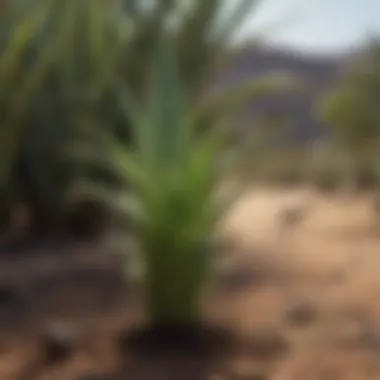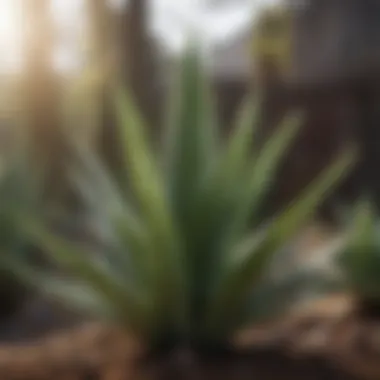Ultimate Guide: How to Care for Your Aloe Vera Plant Like a Pro


Plant Care Profile
Aloe Vera, a succulent plant species known for its numerous therapeutic properties, requires specific care to ensure optimal growth and health. With fleshy, lance-shaped leaves and a gel-like substance used in various medicinal treatments, aloe vera is a valuable addition to any indoor or outdoor garden. Understanding the key aspects of aloe vera care is vital to harnessing its full potential and reaping its benefits.
Optimal Growing Conditions
Aloe vera thrives in well-draining soil and bright, indirect sunlight. It is essential to avoid overwatering, as the roots are susceptible to rot. Providing adequate airflow and maintaining moderate temperatures between 60-75°F (15-24°C) create an environment conducive to healthy aloe vera growth.
Maintenance Tips
Regularly inspecting the plant for pests and diseases, such as mealybugs or root rot, is crucial for preventive care. Adjusting watering schedules based on seasonal changes and fertilizing sparingly can promote vigorous growth. Pruning dead leaves and repotting when overcrowded are essential maintenance practices to ensure the plant's vitality.
Relevance of Care
Proper care sustains the aloe vera plant's well-being, allowing it to flourish and serve its medicinal purposes effectively. Aloe vera's ability to oxygenate the air and purify indoor environments makes it a beneficial addition to homes and workplaces. Additionally, its soothing gel is a natural remedy for skin irritations and burns, underscoring the importance of attentive care for this versatile plant.
As you embark on your journey of nurturing an aloe vera plant, these guidelines will equip you with the knowledge and skills to foster its growth and preserve its health for years to come.
Introduction
Taking care of your aloe vera plant is a task that requires attention to detail and a true understanding of this unique succulent. Aloe vera, known for its healing properties and distinct appearance, is a popular choice among plant enthusiasts. In this comprehensive guide, we will delve into the essential aspects of aloe vera care to help you ensure the optimal well-being of your plant.
Understanding Your Aloe Vera Plant
To care for your aloe vera plant effectively, it is crucial to comprehend its nature and requirements. Aloe vera is a resilient succulent with fleshy, elongated leaves that store water, enabling it to survive in arid conditions. Understanding that aloe vera thrives in dry soil and sunlight-rich environments is fundamental to providing it with the care it needs.


Why Proper Care Is Crucial
Proper care for your aloe vera plant is vital for its overall health and longevity. This succulent is not only aesthetically pleasing but also harbors medicinal properties, making it a valuable addition to any home. By providing the right conditions and care, you can ensure that your aloe vera plant remains vibrant and continues to benefit from its therapeutic qualities.
Setting up the Ideal Environment
When it comes to nurturing your aloe vera plant, setting up the ideal environment is paramount. Creating an optimal environment ensures the plant's overall health and growth potential. Factors such as sunlight exposure, temperature, humidity levels, and soil quality play crucial roles in establishing a thriving setting for your aloe vera. By carefully curating these environmental components, you provide the plant with the necessary conditions to flourish.
Sunlight Requirements
Aloe vera plants have specific sunlight requirements that directly impact their well-being. Understanding the disparity between direct sunlight and indirect sunlight is key to meeting these needs effectively. Direct sunlight offers intense light exposure, which can benefit aloe vera by promoting robust growth and vibrant coloration. Conversely, indirect sunlight provides a milder light source, safeguarding the plant from potential sunburn or dehydration. Both types of light have their advantages, making it essential to strike a balance between the two for optimal plant development.
Direct Sunlight vs. Indirect Sunlight
Direct sunlight exposes the aloe vera plant to direct rays, enhancing its photosynthetic capabilities and stimulating active growth. Indirect sunlight, on the other hand, offers a gentler light intensity that reduces the risk of sun damage, particularly in warmer climates. Balancing these exposure types is crucial, as direct sunlight fuels the plant's energy reserves while indirect sunlight mitigates the risk of sun-induced stress. Understanding and regulating these light sources contribute significantly to the aloe vera plant's vitality and longevity.
Temperature and Humidity Considerations
Maintaining suitable temperature and humidity levels is imperative for the well-being of your aloe vera plant. Aloe vera thrives in warm environments with temperatures ranging between 60-75°F (15-24°C). Consistent monitoring of temperature fluctuations is essential as drastic changes can adversely affect the plant's growth. Moreover, aloe vera prefers moderate humidity levels around 40-60% to prevent excessive dryness or moisture, which can lead to root rot and fungal issues. Striking a harmonious balance in temperature and humidity safeguards the plant's health and vitality.
Choosing the Right Soil
Selecting the appropriate soil for your aloe vera plant is fundamental to its longevity and prosperity. A well-draining potting mix with a sandy texture and good aeration is ideal for aloe vera cultivation. This specialized soil composition facilitates proper drainage, preventing waterlogged conditions that could compromise the plant's root system. Additionally, a pH-balanced soil with added perlite or sand promotes nutrient uptake and prevents water retention, fostering optimal growth conditions for your aloe vera plant.
Watering Needs and Techniques
In the realm of aloe vera plant care, understanding the watering needs and techniques plays a pivotal role in ensuring the optimal health and growth of your plant. Watering is a critical aspect as it directly impacts the well-being of your aloe vera. Consistent and appropriate watering practices are essential to prevent issues such as dehydration or over-hydration, ultimately leading to a thriving plant.


Frequency of Watering
When delving deeper into the frequency of watering your aloe vera plant, you must strike a delicate balance. Overwatering is a common pitfall that many plant owners encounter. This happens when the plant receives more water than it requires, leading to waterlogged soil and root rot. Avoiding overwatering is imperative to the overall health of your aloe vera. By allowing the soil to partially dry out between watering sessions, you can help prevent this issue and promote healthy growth. The unique feature of avoiding overwatering lies in its ability to mimic the plant's natural habitat, where sporadic rainfall prompts the aloe vera to store water efficiently, enhancing its resilience within your care routine.
Proper Watering Technique
Mastering the proper watering technique is key to fostering a flourishing aloe vera. A fundamental aspect to bear in mind is to water the plant deeply but infrequently. This means ensuring that water penetrates deeply into the soil but allowing it to dry out before the next watering session. By following this method, you encourage the aloe vera's roots to grow deeper into the soil, promoting stability and nutrient absorption. Proper watering technique is a cornerstone in preventing issues such as shallow root growth and dehydration. Employing this approach ensures your aloe vera receives adequate moisture while preventing water stagnation, fostering a robust and vibrant plant within your living space.
Aloe Vera Plant Maintenance
Aloe Vera Plant Maintenance is a critical aspect of ensuring the health and vitality of your aloe vera plant. Proper maintenance practices not only enhance the plant's appearance but also contribute to its overall well-being. By investing time and effort into maintaining your aloe vera plant, you can prevent common issues and promote optimal growth.
When it comes to Aloe Vera Plant Maintenance, several key elements need to be considered. Regular pruning and trimming play a significant role in keeping the plant healthy. Additionally, staying vigilant against potential pests and diseases is crucial for the long-term survival of your aloe vera plant. These maintenance tasks may seem simple but are paramount for the plant's health and prosperity.
Pruning and Trimming
Pruning and Trimming are essential practices for ensuring the optimal growth and appearance of your aloe vera plant. When it comes to Removing Dead Leaves, this task is not just about aesthetics but also vital for the plant's health. Dead leaves can trap moisture and attract pests, leading to potential issues. By promptly removing dead leaves, you can prevent these problems and promote better air circulation around the plant.
Removing Dead Leaves is a popular choice for aloe vera enthusiasts because it helps in maintaining the plant's overall vitality. The key characteristic of Removing Dead Leaves lies in its simplicity yet profound impact on the plant's health. By eliminating decaying foliage, you are allowing the plant to channel its resources towards new growth, ultimately leading to a more vibrant and resilient aloe vera.
An advantage of Removing Dead Leaves is its preventive nature against potential diseases. Dead leaves can serve as breeding grounds for harmful microbes, which can threaten the well-being of your aloe vera plant. By practicing regular leaf removal, you are creating a healthier environment for your plant to thrive.
Dealing with Pests and Diseases
Properly handling pests and diseases is crucial in maintaining a healthy aloe vera plant. Common Pests to Watch Out For can pose a significant threat if left unchecked. Identifying and addressing pest and disease issues promptly can prevent widespread infestations and damage to your plant.
Common Pests to Watch Out For include aphids, mealybugs, and spider mites, which are common adversaries of aloe vera plants. Understanding the signs of infestation and implementing appropriate control measures are essential in protecting your plant. These pests can weaken the plant and hinder its growth if not addressed in a timely manner.


One beneficial aspect of Common Pests to Watch Out For awareness is the ability to proactively safeguard your aloe vera plant. By recognizing early symptoms of pest infestation, you can take preventative measures to mitigate the spread and preserve the plant's health. Regular inspection and vigilance are key in combating these unwanted invaders.
The unique feature of Common Pests to Watch Out For is their adaptability and resilience. These pests can quickly multiply and establish colonies on your plant, causing damage within a short period. Therefore, staying informed about common pests and their behaviors empowers you to protect your aloe vera plant effectively.
Harvesting Aloe Vera
When it comes to caring for your aloe vera plant, harvesting is a crucial aspect that ensures the plant's sustainability and your ability to benefit from its healing properties. Harvesting aloe vera not only promotes plant health but also allows you to harness its gel for various uses, including skincare and medicinal purposes.
Knowing When to Harvest
Determining the right time to harvest your aloe vera plant is key to maximizing its potency. Typically, aloe vera leaves are ready for harvest once they reach a mature size, usually around 8-10 inches in length. The leaves should be plump and firm to the touch, indicating they are full of the nourishing gel aloe vera is known for.
Harvesting Techniques
When it's time to harvest your aloe vera leaves, proper techniques ensure minimal damage to the plant while extracting the gel efficiently. To harvest, gently twist or cut off mature leaves at the base, ensuring you do not harm the surrounding foliage. These leaves can then be stored for immediate use or processing.
Preservation Methods
Preservation methods play a vital role in maintaining the quality and efficacy of harvested aloe vera gel. One popular preservation technique involves refrigerating fresh aloe vera gel in an airtight container to prolong its shelf life and retain its medicinal benefits. This method preserves the gel's soothing properties and ensures it remains potent for longer.
In this article, preservation methods like refrigeration are essential for readers looking to make the most of their harvested aloe vera. By understanding how to preserve aloe vera gel properly, individuals can continue to harness its healing properties over an extended period. The refrigeration technique stands out for its simplicity and effectiveness, making it a preferred choice for those seeking to incorporate aloe vera into their skincare or medicinal routines.
Conclusion
Maintaining a healthy aloe vera plant is not just a task, but a commitment to nurturing a living organism. The concluding section of this comprehensive guide solidifies the importance of consistent care and attention to detail when it comes to cultivating a thriving aloe vera plant. Aloe vera, known for its numerous health benefits and versatile uses, deserves to be maintained with diligence. By following the guidelines outlined in this guide, plant enthusiasts can ensure the longevity and vitality of their aloe vera specimens. Whether it is understanding the optimal growing conditions, implementing effective maintenance practices, or being vigilant against potential threats, each aspect plays a vital role in nurturing a healthy aloe vera plant. As the journey of plant care continues, remember that every effort put into maintaining aloe vera reaps rewards of beauty and well-being for both the plant and its caregiver.
Maintaining a Healthy Aloe Vera Plant
In the pursuit of keeping your aloe vera plant in prime condition, attention to detail is paramount. Regular monitoring of the plant's growth, hydration levels, and overall well-being is essential for its longevity. Safeguarding against common pests and diseases through preventive measures is key to sustaining a healthy aloe vera plant. Pruning dead or damaged leaves, promoting proper drainage in the soil, and providing adequate sunlight are fundamental practices to ensure optimal growth and resilience. Furthermore, understanding the unique characteristics of aloe vera, such as its minimal water requirements and susceptibility to overwatering, can guide caregivers in offering tailored care that aligns with the plant's natural needs. By incorporating these strategies into your plant care routine, you not only promote the well-being of your aloe vera but also deepen your connection with nature through nurturing a living organism.
Final Tips for Success
As you embark on your journey of caring for an aloe vera plant, here are some final tips to enhance your success in plant cultivation. Firstly, prioritize consistency in care by establishing a routine for watering, monitoring, and maintenance. Regularly inspect your plant for signs of stress, pests, or other issues that may require immediate attention. Secondly, avoid over-fertilizing your aloe vera, as this can disrupt its natural growth patterns and lead to nutrient imbalances. Opt for a balanced fertilizer specifically designed for succulents to support healthy development. Lastly, embrace the learning process that comes with plant care. Each aloe vera plant is unique, and understanding its individual quirks and preferences will empower you to provide personalized care tailored to its specific needs. By staying observant, patient, and responsive to your plant's requirements, you can forge a rewarding relationship with your aloe vera while fostering its flourishing growth and resilience.







